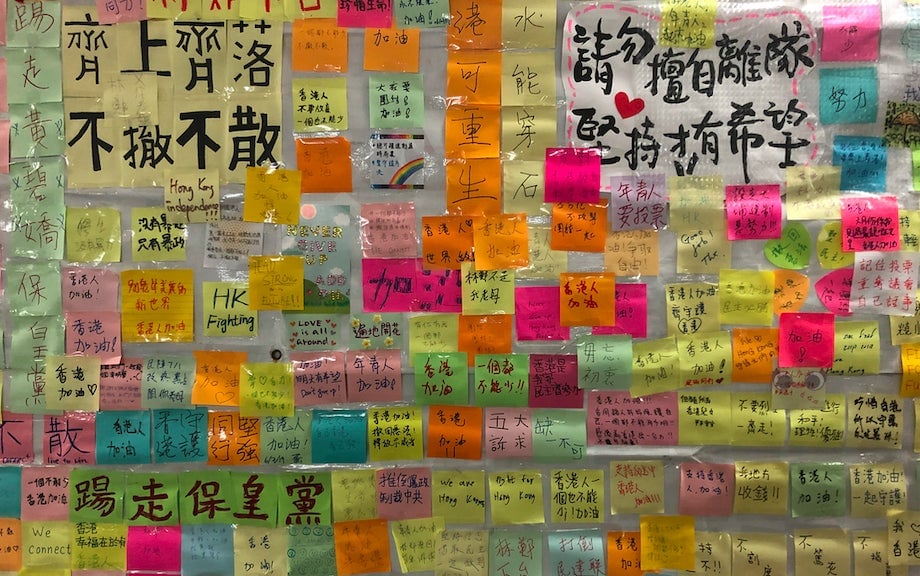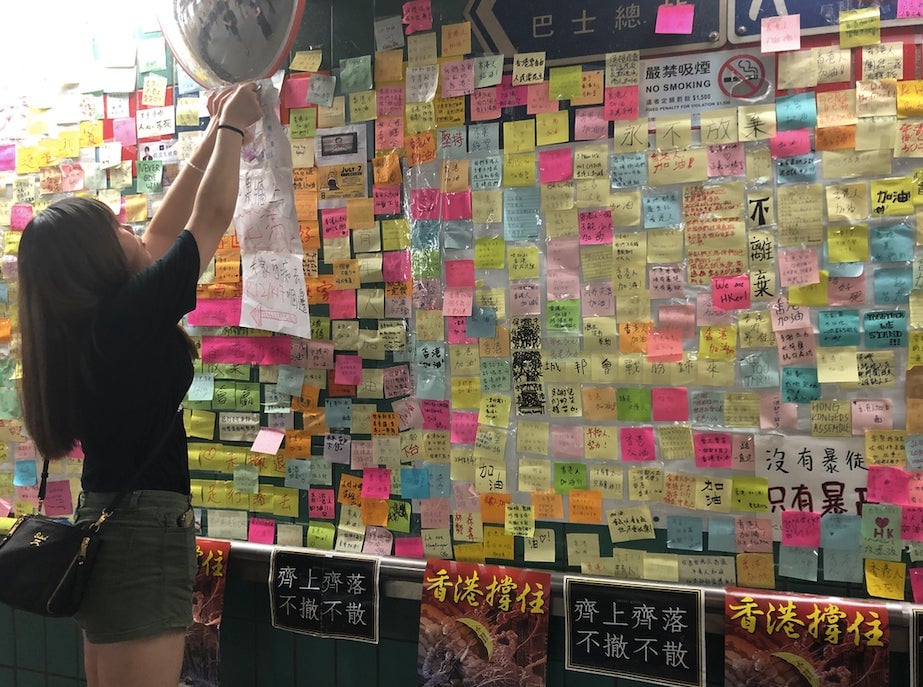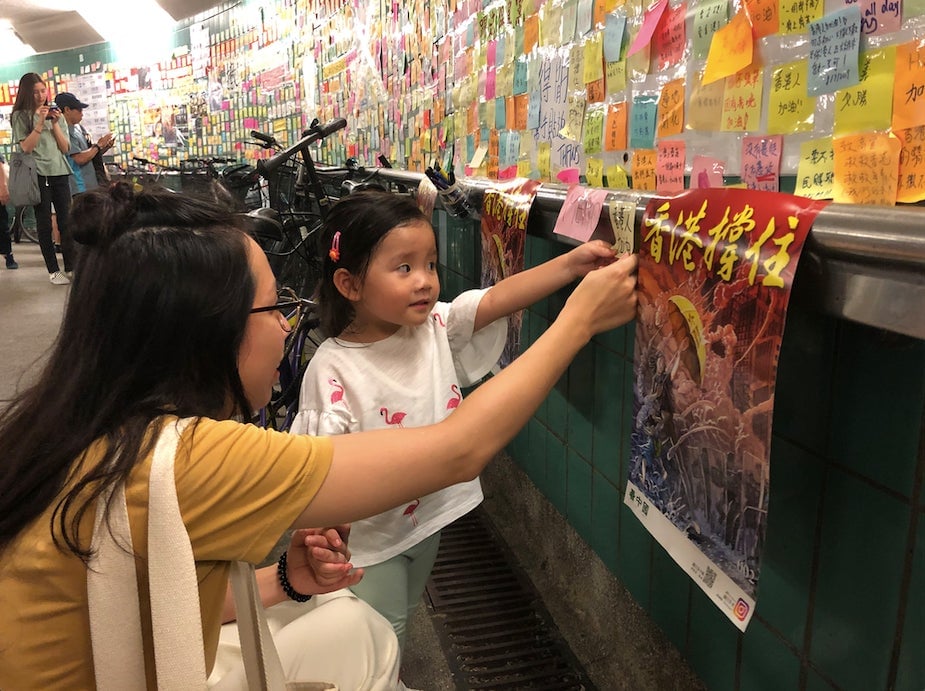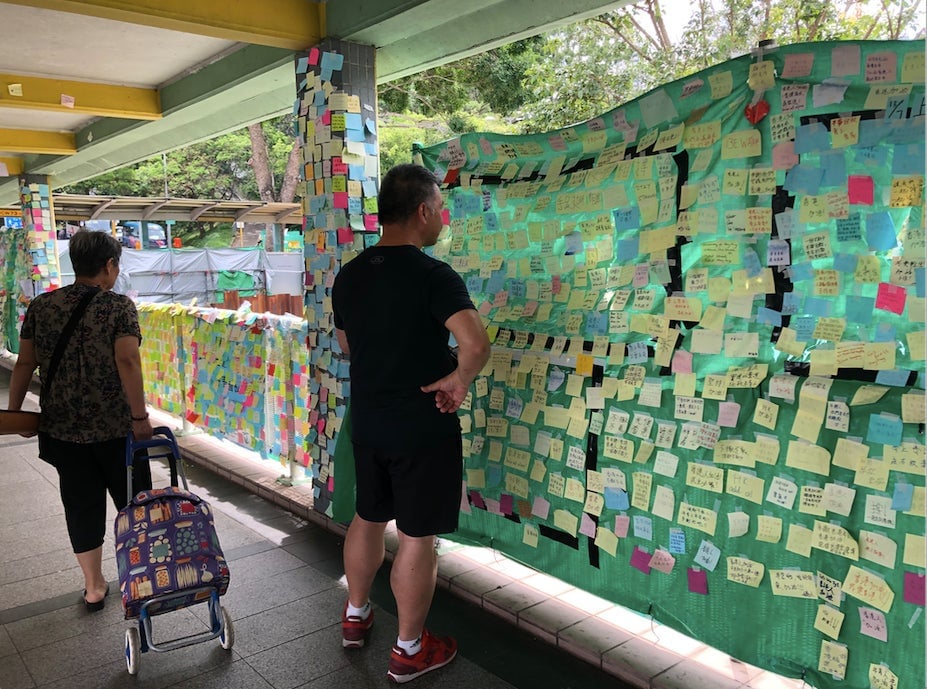Post-it notes are the new weapon of choice for Hong Kong’s protesters
To their arsenal of hard hats, umbrellas, and goggles, Hong Kong’s protesters, who have been taking to the streets for over a month in response to a hated extradition bill, are now adding another item—Post-it notes. Hundreds and thousands of them.


To their arsenal of hard hats, umbrellas, and goggles, Hong Kong’s protesters, who have been taking to the streets for over a month in response to a hated extradition bill, are now adding another item—Post-it notes. Hundreds and thousands of them.
All across the city’s districts—from its financial hub to the suburbs neighboring mainland China and outlying islands—walls big and small covered with colorful pieces of paper with the thoughts and wishes of Hong Kong people are sprouting up. Their inscriptions range from inspiring quotes by Martin Luther King, Jr. to expletive-laden calls for death to police. It’s the latest in a strategy protesters are calling “flowers blossoming everywhere,” a Chinese saying appropriated to signify that the recent protest movement in Hong Kong has now spread far from its downtown epicenter to neighborhoods everywhere.
They’re called Lennon Walls, named for the original section of a concrete staircase near Hong Kong’s government complex that was covered with Post-its during the 2014 Umbrella Movement. The name itself was adopted from the John Lennon Wall in Prague, a place where Czech youth expressed their political thoughts through graffiti and Beatles lyrics.
Crystal Cheung, a 41-year-old church worker, started a Lennon Wall in the Jordan district as a massive protest aimed at communicating Hong Kong people’s grievances to mainland Chinese tourists was underway nearby. This year’s protests began as opposition to a proposed law that would have made it possible to send people from Hong Kong to mainland China to stand trial, but now encompass broader concerns over the city’s autonomy from mainland China. Cheung described the wall as a place for people to know that “they are not alone” as they walk past and read the messages.
But the Lennon Wall has now evolved from being a sort of emotional support station to becoming a central part of the protesters’ toolkit. In recent days, such walls have been springing up with increasing frequency, their appearances flagged with excitement on social networks with calls for people to donate supplies, and for volunteers to guard them from angry passers-by. Incidents of people tearing down the notes, usually older people with pro-China views, are frequent. The walls, however, are quickly re-populated in a sort of Lennon Wall whack-a-mole.
One Lennon Wall in the busy Mong Kok district in a claw-machine arcade even got around the problem by putting up sticky notes on its glass walls from inside the store. A warning read that staff would call the police if anyone tried to destroy “private property.”
Elsewhere, a young woman also named Crystal decided to watch over an unusually large Lennon Wall at an underpass near Tai Po Market train station, a residential area and busy transport interchange in the city’s northern suburbs, after she watched a man angrily tearing down bits of paper on a live feed on a Facebook page for the area’s residents. The 21-year-old, who would only give her first name and said she was presently unemployed, worked to protect the pieces of paper by covering them with large sheets of plastic wrap, as buses and trains disgorged steady streams of people through the labyrinthine tunnel. Many stopped to add to the expanding wall or simply peruse the messages while engaging in spirited discussions of Hong Kong’s political crisis.
“The wall has a real impact. Other people can read our views. It can help change the opinions of people who didn’t originally support us… It’s only with the support of the people that we can continue down this path of resistance,” said Crystal.

The protests against the much-maligned extradition bill began over a month ago, and brought millions of people out to the streets of Hong Kong. Fueled by the government’s refusal to fully withdraw the bill and growing anger over issues such as police brutality and a lack of democracy, the protests have continued and shape-shifted into what participants say are “fluid” tactics to maintain pressure on the government while taking their message all around Hong Kong.
Cassie Chan, a 31-year-old flight attendant who took her toddler to the Tai Po Market Lennon Wall, said it was important that people outside of the downtown areas that usually play host to major political demonstrations can better understand what protesters are thinking.

“This is particularly important for older people who don’t usually leave this area. They tend to receive very one-sided information,” she said.
At another Lennon Wall in Fanling, a neighborhood just two stops by train from the border with mainland China, Ah Yi, a 16-year-old high-school student, stood guard over hundreds of Post-it notes stuck gingerly to green canvas sheets on a pedestrian footbridge. Wearing her school uniform, she said she had come “mentally prepared” for disturbances. That morning, she listened as elderly men berated the protesters, she said, including one man who spat on the bits of paper.

“After he walked away I wiped down the paper and then threw the tissue away,” said Ah Yi, who only gave her first name. “If they pull down one piece of paper, we’ll put up 10 more.”